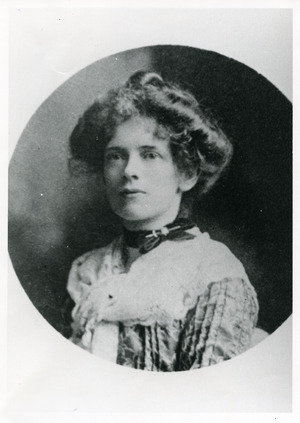Jeannie Gunn facts for kids
Jeannie Gunn OBE (known by her pen name, Mrs Aeneas Gunn) was an important Australian writer and teacher (1870–1961). Her books helped many people learn about life in the Australian outback. She also spent time helping Australian soldiers and their families.
Contents
Jeannie Gunn: An Australian Storyteller
Jeannie Taylor was born in Carlton, Melbourne, Australia, on June 5, 1870. She was the youngest of five children. Her father was a Baptist minister who later worked for a newspaper. Jeannie was educated at home and then studied at Melbourne University. From 1889 to 1896, she ran a school with her sisters. After that, she worked as a visiting teacher.
Early Life and Adventures
On New Year's Eve in 1901, Jeannie married Aeneas James Gunn, an explorer and journalist. Soon after, in early 1902, they traveled to Darwin, which was then called Palmerston. From there, they moved to Elsey Station, a large cattle farm far away from towns. This station was located on the Roper River, near the modern town of Mataranka. Jeannie lived at Elsey for about a year. Sadly, her husband passed away in March 1903 due to an illness. After this, Jeannie returned to live in Melbourne.
Writing the Outback
Back in Melbourne, Jeannie's friends encouraged her to write about her amazing experiences in the Northern Territory. This led to her becoming a famous author.
The Little Black Princess
Her first book, The Little Black Princess: a True Tale of life in the Never-Never Land, was published in 1905. It was updated in 1909. This book told the true story of an Indigenous Australian girl named Bett-Bett and her childhood.
We of the Never Never
Jeannie's second book, We of the Never Never, came out in 1908. Even though it was written like a novel, it was actually a true story of her time at Elsey Station. She only changed the names of the people to protect their privacy. This book became incredibly popular. Over 30 years, it sold more than 300,000 copies. It was even translated into German in the 1920s. By 1990, over a million copies had been sold! In a 1931 poll, readers voted her the third most popular Australian novelist. The book helped people imagine what life was like in the remote parts of Australia.
Helping Others and Later Years
During the First World War, Jeannie Gunn dedicated her time to helping Australian soldiers who were serving overseas. After the war, she continued to support returned servicemen. She worked with government departments and became a patron of the Monbulk RSL (Returned and Services League of Australia). She attended many of their events for over twenty years. In 1939, she was recognized for her contributions and was appointed an Officer of the Order of the British Empire. Although she didn't write another full novel, she did publish more stories about the characters from her earlier books.
Jeannie Gunn passed away in Hawthorn in 1961. Her memories of working with the RSL were published in a book called My Boys: A Book of Remembrance in 2000.
Why Her Books Mattered
We of the Never Never is considered an important book because it helped describe the unique Australian landscape and way of life. Even in 1908, many Australians lived in cities. Her book showed a different side of Australia, creating a picture of heroic lives in the outback. It showed a place where people lived in tune with nature and the challenges of the land. In 1988, a major literary history book called it a "minor masterpiece of Australian letters."
Her writings also provided valuable historical information. For example, in 1991, a land claim was made for the old Elsey cattle station area. A judge, Peter Gray, looked at Jeannie Gunn's work. Her descriptions helped to understand the history of the people who had lived on that land for a long time.


